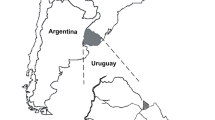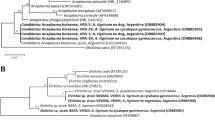Abstract
A total of 3552 Ixodes persulcatus from Sverdlovsk, Chelyabinsk, Novosibirsk, Irkutsk regions and Khabarovsk Territory were examined on the Ehrlichia and Anaplasma presence by nested PCR based on the 16S rRNA gene. Both Anaplasma phagocytophilum and Ehrlichia muris DNA were found in I. persulcatus in all studied regions — A. phagocytophilum was detected in 1.3–6.3% of ticks and E. muris — in 2.0–14.1% of ticks. Moreover, “Candidatus Neoehrlichia mikurensis” DNA was found in 8 ticks collected in Novosibirsk, Irkutsk Regions and Khabarovsk Territory. Partial nucleotide sequences of 16S rRNA gene and groESL operone (1240–1300 bp) were determined for 65 samples of A. phagocytophilum, 17 samples of E. muris and 4 samples of “Candidatus Neoehrlichia mikurensis”. Nucleotide sequences of 16S rRNA gene and groESL operone of E. muris and “Candidatus Neoehrlichia mikurensis” were shown to be highly conservative, and nucleotide sequences of groESL operone of both E. muris and “Candidatus Neoehrlichia mikurensis” differed from the sequences found previously in other species of Ixodid tick. On the basis of analysis of the 16S rRNA gene and groESL operone sequences it was concluded that all revealed samples A. phagocytophilum could be divided into 2 groups. GroESL operone sequences of A. phagocytophilum from the first group were identical to each other but significantly differed from the known groESL operone sequences (less than 98.2% of similarity), whereas their 16S rRNA gene sequences were identical to the sequence of widely distributed and pathogenic for human A. phagocytophilum genetic variant (CAHU-HGE1, GenBank AF093788) or differed from it by a single nucleotide substitution. The nucleotide sequences of groESL operone of A. phagocytophilum from the second group differed from each other by 1–4 nucleotides and were closely related (99.2–99.4% of similarity) to the sequences of groESL operone of A. phagocytophilum isolates found in Europe in Ixodes ricinus and roe deer. The nucleotide sequences of the 16S rRNA gene of A. phagocytophilum from the second group were most similar to the sequence of the rare A. phagocytophilum genetic variant previously found only in China (GenBank DQ342324).
Similar content being viewed by others
References
Afanasieva, M.V., Vorob’eva, N.N., Korenberg, E.I., et al., Infekts. Bol., 2006, vol. 4, no. 2, pp. 24–28.
Grigoryan, Y.V., Korenberg, E.I., Vorob’eva, N.N., et al., Epid. Infekts. Bol., 2000, no. 6, pp. 20–23.
Kozlova, I.V., Zlobin, V.I., Verkhozina, M.M., et al., Byul. VSNTs SO RAMN, 2007, no. 3, suppl., pp. 112–116.
Rar, V.A., Pukhovskaya, N.M., Vysochina, N.P., et al., Byul. VSNTs SO RAMN, 2007, no. 3, suppl., pp. 156–159.
Rar, V.A., Fomenko, N.V., Mel’nikova, O.V., and Chernousova N.Ja., Byu. Sib. Med., 2008, vol. 7,suppl. 1, pp. 73–77.
Semenov, A.V., Alekseev, A.N., Dubinina, Ye.V., et al., Med. Parazitol., 2001, no. 3, pp. 11–15.
Sidel’nikov, Yu.N., Mediannikov, O.Yu., Ivanov, L.I., and Zdanovskaya, N.I., Klin. Med., 2003, no. 2, pp. 67–68.
Telford, S.R., 3rd, Korenberg, E.I., Goethhert, H.K., et al., Zh. Mikrobiol. Epidemiol. Immunobiol., 2002, no. 6, pp. 21–25.
Shpynov, S.N., Rudakov, N.V., Yastrebov, V.K., et al., Med. Parazitol., 2004, no. 2, pp. 10–14.
Alberti, A., Addis, M.F., Sparagano, O., et al., Emerg. Infect. Dis., 2005, vol. 11, pp. 1322–1324.
Alekseev, A.N., Dubinina, H.V., Van de Pol, I., et al., J. Clin. Microbiol., 2001, vol. 39, pp. 2237–2342.
Cao, W.C., Zhao, Q.M., Zhang, P.H., et al., Am. J. Trop. Med. Hyg., 2003, vol. 68, pp. 547–550.
Cao, W.C., Zhan, L., He, J., et al., Am. J. Trop. Med. Hyg., 2006, vol.75, pp. 664–668.
Chen, S.M., Dumler, J.S., Bakken, J.S., et al., J. Clin. Microbiol., 1994, vol. 32, pp. 589–595.
Dumler, J.S., Madigan, J.E., Pusterla, N., and Bakken, J.S., Clin. Infect. Dis., 2007, vol. 45,suppl. 1, pp. 545–551.
Fehr, J.S., Bloemberg, G.V., Ritter, C., et al., Emerg. Infect. Dis., 2010, vol. 16., pp. 1127–1129.
Kawahara, M., Ito, T., Suto, C., et al., J. Clin. Microbiol., 1999, vol. 37, pp. 1123–1129.
Kawahara, M., Rikihisa, Y., Isogai, E., et al., Int. J. Syst. Evol. Microbiol., 2004, vol. 54, pp. 1837–1843.
Kim, C.M., Kim, M.S., Park, M.S., et al., Vector Borne Zoonotic Dis., 2003, vol. 3, pp. 17–26.
Liz, J.S., Anderes, L., Sumner, J.W., et al., J. Clin. Microbiol., 2000, vol. 38, pp. 1002–1007.
Massung, R.F., Mauel, M.J., Owens, J.H., et al., Emerg. Infect. Dis., 2002, vol. 8, pp. 467–472.
Massung, R.F., Priestley, R.A., Miller, N.J., et al., J. Infect. Dis., 2003, vol. 188, pp. 1757–1763.
Ohashi, N., Inayoshi, M., Kitamura, K., et al., Emerg. Infect. Dis., 2005, vol. 11, pp. 1780–1783.
Parola, P., Davoust, B., Raoult, D., et al., Vet. Res., 2005, vol. 36, pp. 469–492.
Ravyn, M.D., Korenberg, E.I., Oeding, J.A., et al. Lancet, 1999, vol. 353, pp. 722–723.
Schouls, L.M., van de Pol, I., Rijpkema, S.G., and Schot, C.S., J. Clin. Microbiol., 1999, vol. 37, pp. 2215–2222.
Spitalská, E., Boldis, V., Kostanová, Z., et al., Acta Virol., 2008, vol. 52, pp. 175–179.
Stuen, S., Moum, T., Petrovec, M., and Schouls, L.M., Int. J. Med. Microbiol., 2006, vol. 296, pp. 164–166.
Sumner, J.W., Nicholson, W.L., and Massung, R.F., J. Clin. Microbiol., 1997, vol. 35, pp. 2087–2092.
Takano, A., Ando, S., Kishimoto, T., et al., Microbiol. Immunol., 2009, vol. 53, pp. 101–106.
von Loewenich, F.D., Geissdörfer, W., Disqué, C., et al., J. Clin. Microbiol., 2010, vol. 48, pp. 2630–2635.
Welinder-Olsson, C., Kjellin, E., Vaht, K., et al., J. Clin. Microbiol., 2010, vol. 48, pp. 1956–1959.
Wen, B., Rikihisa, Y., Mott, J., et al., Int. J. Syst. Bacteriol., 1995, vol. 45, pp. 250–254.
Author information
Authors and Affiliations
Corresponding author
Additional information
Original Russian Text © V.A. Rar, T.I. Epikhina, N.N. Livanova, V.V. Panov, E.K. Doroschenko, N.M. Pukhovskaya, N.P. Vysochina, L.I. Ivanov, 2011, published in Molekulyarnaya Genetika, Mikrobiologiya i Virusologiya, 2011, No. 2, pp. 17–23.
The article was translated by the authors.
About this article
Cite this article
Rar, V.A., Epikhina, T.I., Livanova, N.N. et al. The study of heterogeneity of 16S rRNA gene and groESL operone in DNA samples of Anaplasma phagocytophilum, Ehrlichia muris, and “Candidatus Neoehrlichia mikurensis” determined in Ixodes persulcatus ticks on the territory of Ural, Siberia and Far East of Russia. Mol. Genet. Microbiol. Virol. 26, 66–73 (2011). https://doi.org/10.3103/S0891416811020091
Received:
Published:
Issue Date:
DOI: https://doi.org/10.3103/S0891416811020091




